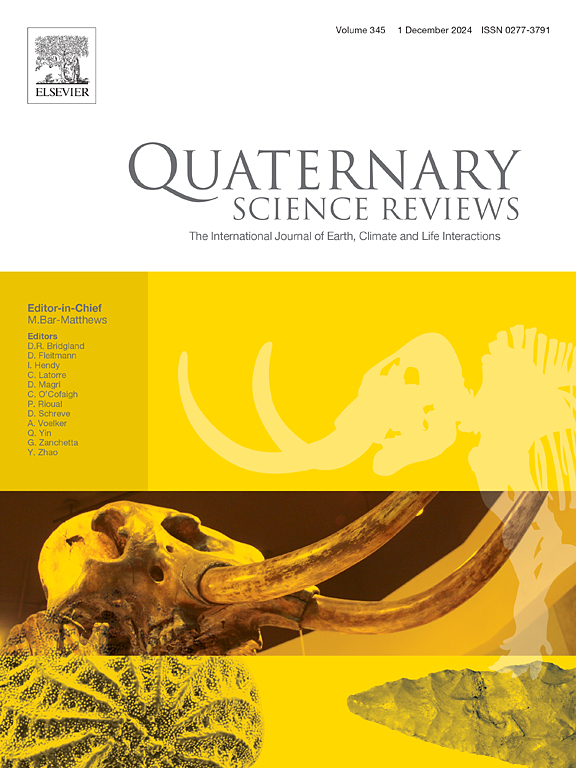晚第四纪气候变化与构造隆起的地貌特征:来自北京平谷盆地的启示
IF 3.2
1区 地球科学
Q1 GEOGRAPHY, PHYSICAL
引用次数: 0
摘要
了解构造和气候对景观演变的相对影响是地貌学的一个基本挑战,特别是在经历重大气候变化的构造活跃的板内地区。本文以燕山与华北平原交界的平谷盆地为研究对象,探讨了这些作用力在晚第四纪河流景观形成过程中的相互作用。通过详细的地貌填图、地层分析和多代年代学(OSL、14C、10Be-26Al、古地磁),重建了盆地的地貌和沉积历史。我们的研究结果揭示了在晚更新世晚期(~ 17 ka)前后发生的一次关键的、以前没有记录的构造制度转变,从一个以沉降为主的长时期沉积(~ 141 ka - 17 ka)过渡而来,特征为>;50 m的冲积扇辫状河和风积沉积物堆积,进入区域隆升促进河流持续切割的阶段。根据这一基本的构造重组,我们证明了巨河沿岸的5个不同的河流阶地(T1-T5)主要以晚更新世至全新世的气候变化为节奏。阶地年龄与主要气候转变密切相关,包括MIS 3/4、末次冰期-全新世转变以及随后影响东亚季风的全新世气候波动。这种气候驱动的形成机制,在区域隆起的背景下运作,提供了切割的可能性,与先前强调局部断层控制的解释形成对比。此外,我们重建了巨河水系的演变,记录了朝向侵蚀、河流捕获和至少三个主要河道迁移,作为对这种构造和气候联合强迫的响应。这项研究为大陆景观形成过程中板内构造和气候变化的复杂相互作用和层次控制提供了重要见解,为全球类似的构造活跃、气候敏感地区提供了有价值的、约束良好的模拟。本文章由计算机程序翻译,如有差异,请以英文原文为准。
Geomorphic signature of late Quaternary climate change and tectonic upheaval: Insights from the Pinggu Basin, Beijing
Understanding the relative influence of tectonics and climate on landscape evolution is a fundamental challenge in geomorphology, particularly in tectonically active intraplate regions experiencing significant climatic shifts. This study investigates the Pinggu Basin, located at the transition between the Yanshan Mountains and the North China Plain, to decipher the interplay of these forces in shaping fluvial landscapes during the late Quaternary. Through detailed geomorphological mapping, stratigraphic analysis, and multi-proxy chronological dating (OSL, 14C, 10Be-26Al, paleomagnetism), we reconstruct the basin's geomorphic and sedimentary history. Our results reveal a critical, previously undocumented tectonic regime shift around the late Late Pleistocene (∼17 ka), transitioning from a prolonged period of subsidence-dominated deposition (∼141 ka - 17 ka), characterized by > 50 m of alluvial fan-braided river and aeolian sediment accumulation, to a phase of regional uplift promoting sustained fluvial incision. Following this fundamental tectonic reorganization, we demonstrate that the five distinct fluvial river terraces levels (T1-T5) along the Ju River, was primarily paced by Late Pleistocene to Holocene climate variability. Terrace ages correlate strongly with major climate transitions, including MIS 3/4, the Last Glacial-Holocene transition, and subsequent Holocene climatic fluctuations influencing the East Asian Monsoon. This climate-driven formation mechanism, operating within the context of regional uplift that provided the potential for incision, contrasts with previous interpretations emphasizing localized fault control. Furthermore, we reconstruct the evolution of the Ju River system, documenting headward erosion, river capture and at least three major channel migrations, as a response to this combined tectonic and climatic forcing. This study provides critical insights into the complex interplay and hierarchical controls of intraplate tectonics and climate change in shaping continental landscapes, offering a valuable, well-constrained analogue for similar tectonically active, climate-sensitive regions globally.
求助全文
通过发布文献求助,成功后即可免费获取论文全文。
去求助
来源期刊

Quaternary Science Reviews
地学-地球科学综合
CiteScore
7.50
自引率
15.00%
发文量
388
审稿时长
3 months
期刊介绍:
Quaternary Science Reviews caters for all aspects of Quaternary science, and includes, for example, geology, geomorphology, geography, archaeology, soil science, palaeobotany, palaeontology, palaeoclimatology and the full range of applicable dating methods. The dividing line between what constitutes the review paper and one which contains new original data is not easy to establish, so QSR also publishes papers with new data especially if these perform a review function. All the Quaternary sciences are changing rapidly and subject to re-evaluation as the pace of discovery quickens; thus the diverse but comprehensive role of Quaternary Science Reviews keeps readers abreast of the wider issues relating to new developments in the field.
 求助内容:
求助内容: 应助结果提醒方式:
应助结果提醒方式:


